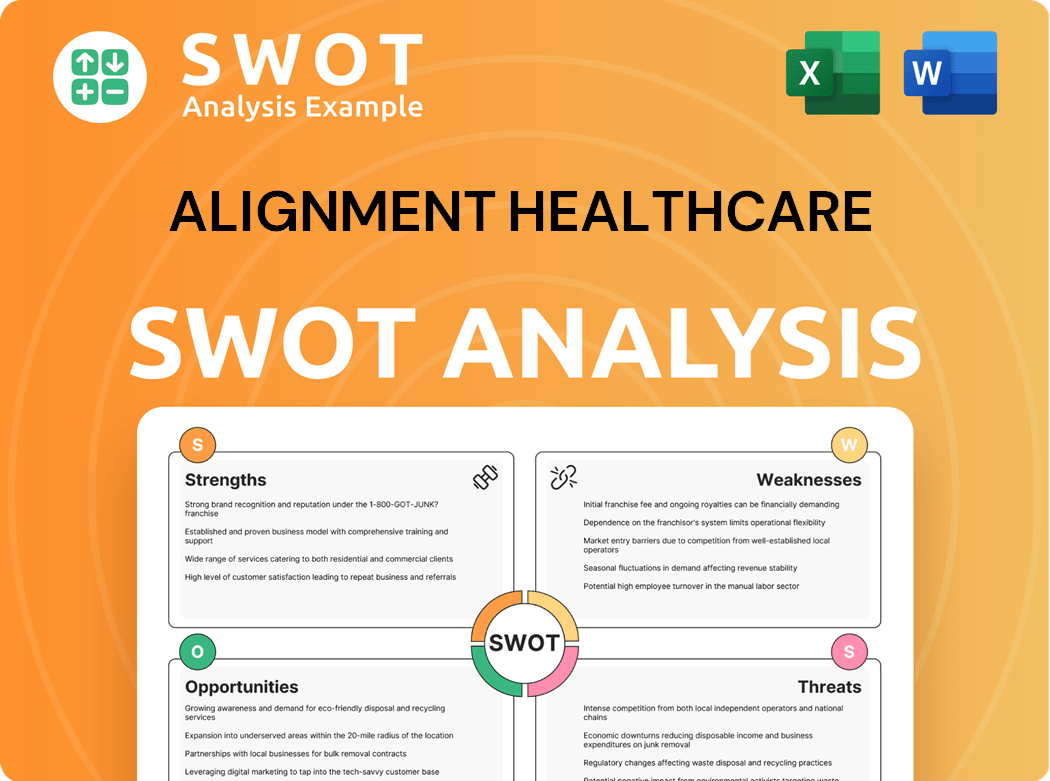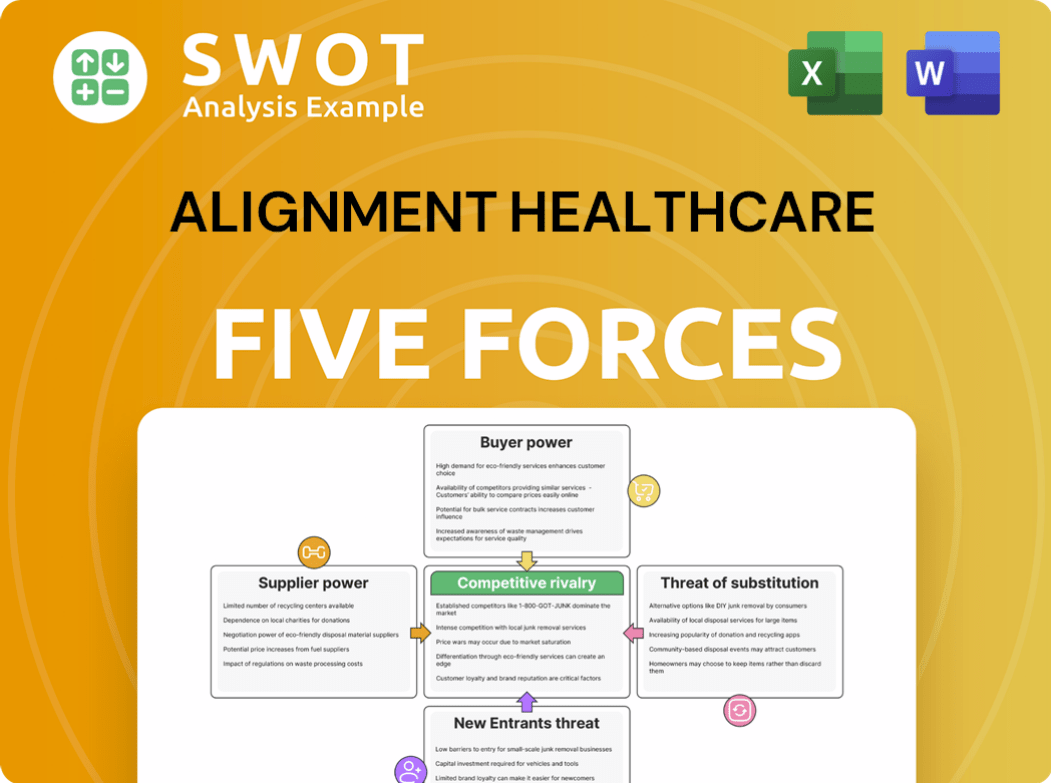Alignment Healthcare Bundle
How did Alignment Healthcare revolutionize senior care?
Embark on a journey through the dynamic evolution of Alignment Healthcare, a Alignment Healthcare SWOT Analysis reveals the core of its success. Founded in 2013, this healthcare company has rapidly carved a niche in the Medicare Advantage sector. Discover how its innovative 'high-tech, high-touch' model has reshaped the landscape of senior care.

From its inception in Orange, California, Alignment Health set out to simplify and enhance healthcare for seniors. Its commitment to personalized, cost-effective care has fueled significant growth, with membership soaring to approximately 209,900 members by January 1, 2025. Explore the company's mission, its Alignment Healthcare SWOT Analysis, and the key milestones that have shaped its remarkable trajectory in the Medicare Advantage market and its impact on the health insurance industry.
What is the Alignment Healthcare Founding Story?
The story of Alignment Healthcare began in 2013 in Orange, California. It's a tale rooted in personal experience and a vision for a better healthcare system. The founder's motivation was deeply personal, shaped by his own family's healthcare journey.
John Kao, the founder and CEO, started the company after witnessing firsthand the challenges of navigating the healthcare system with his mother after she suffered a heart attack. He identified significant gaps in care coordination, communication, and medication management, particularly for seniors. This experience highlighted the need for a more efficient and patient-centered approach to healthcare.
Kao's vision was to create a tech-enabled platform designed to deliver customized care to seniors. The initial business model centered around a concierge-like service model, leveraging a robust data engine to proactively identify members' needs and risk status. The goal was to provide high-quality, affordable care for its Medicare Advantage members.
While the exact details of early funding are not readily available, the company secured significant investments later on to fuel its growth.
- In 2020, Alignment Healthcare secured a $135 million Series C round.
- Investors included Fidelity Investments, T. Rowe Price, and Durable Capital Partners.
- The funding was earmarked to accelerate growth and enhance its technology platform.
The core mission of this healthcare company was to build a healthcare system that prioritizes high-quality, cost-effective care for seniors. This involved partnering with providers to ensure coordinated care. As of 2024, Alignment Healthcare continues to focus on its mission, providing Medicare Advantage plans and healthcare services to seniors across various locations.
Alignment Healthcare SWOT Analysis
- Complete SWOT Breakdown
- Fully Customizable
- Editable in Excel & Word
- Professional Formatting
- Investor-Ready Format

What Drove the Early Growth of Alignment Healthcare?
Following its 2013 founding, the Healthcare company known as Alignment Healthcare experienced rapid growth, initially concentrating on California. Their approach, which emphasized tech-enabled, personalized care, resonated with the market. By 2020, Alignment Health operated in California and North Carolina, serving 81,500 members across over 20 markets. This period marked significant expansion and strategic moves for the company.
In 2021, Alignment Healthcare significantly expanded its footprint, entering new markets in California, Nevada, and North Carolina. The goal was to reach over 5.9 million Medicare-eligible individuals. This expansion included the introduction of a signature virtual health plan. This growth strategy was crucial for increasing their market presence.
A key milestone was the initial public offering (IPO) on March 26, 2021. The company listed on the Nasdaq Global Select Market under the ticker 'ALHC'. The IPO priced at $18 per share, aiming to raise nearly $500 million to support future expansion. This financial move was pivotal for the Healthcare company's growth.
By the end of 2021, Alignment Healthcare surpassed $1 billion in annual revenues and doubled its geographic footprint to 38 counties across Arizona, California, Nevada, and North Carolina, reaching 7 million Medicare-eligible seniors. The company also expanded its plan offerings to 42, including more special needs plans. Early customer acquisition strategies focused on their differentiated care model and supplemental benefits. To learn more about their approach, see Marketing Strategy of Alignment Healthcare.
Despite rapid growth, the company faced the challenge of balancing aggressive expansion with maintaining profitability. This strategic dilemma was a key focus, as the Alignment Health leadership navigated the complexities of scaling their operations. The expansion required careful financial management and strategic planning.
Alignment Healthcare PESTLE Analysis
- Covers All 6 PESTLE Categories
- No Research Needed – Save Hours of Work
- Built by Experts, Trusted by Consultants
- Instant Download, Ready to Use
- 100% Editable, Fully Customizable

What are the key Milestones in Alignment Healthcare history?
Alignment Healthcare has achieved several significant milestones since its inception, marking its growth and impact in the healthcare sector. The company history reflects its commitment to innovation and patient-centered care within the Medicare Advantage market.
| Year | Milestone |
|---|---|
| 2014 | Founded with a focus on providing comprehensive healthcare services to seniors. |
| 2016 | Expanded its service area and began to implement its proprietary technology platform, AVA. |
| 2021 | Became a publicly traded company, signaling a major step in its growth trajectory. |
| 2023 | Reported a membership of over 100,000 members across multiple states. |
Alignment Health has consistently introduced innovative solutions to improve healthcare delivery. A key aspect of their approach involves leveraging technology and specialized plans to meet diverse patient needs within the health insurance landscape.
AVA uses artificial intelligence to analyze patient data, predict health risks, and personalize care plans. This technology helps in identifying high-risk members and optimizing interventions, leading to better outcomes.
Offers a 'high-touch' approach with a dedicated concierge team available around the clock to assist members. This service focuses on providing personalized support and guidance to enhance the patient experience.
Introduced plans tailored to specific populations, including those for Asian and Hispanic seniors and individuals with chronic conditions. These plans are designed to address the unique needs of diverse patient groups.
In 2021, Alignment Healthcare became the first payer to cover the Galleri early-detection blood test for cancer. This innovation underscores its commitment to proactive healthcare and early intervention.
Provides supplemental benefits that address social determinants of health, such as allowances for groceries, utilities, and transportation. This holistic approach aims to improve overall patient well-being.
Offers a virtual health plan to provide convenient access to care through telehealth services. This plan enhances accessibility and convenience for members, especially those in remote areas.
Despite its innovations, Alignment Healthcare faces several challenges. The healthcare company has struggled with achieving consistent profitability, and regulatory changes also pose significant hurdles.
Like other insurtech companies, Alignment Healthcare has faced challenges in achieving consistent profitability. The company has reported net losses in the past, even while aiming for adjusted EBITDA profitability.
Changes in Medicare Advantage rules and star ratings calculations impact the company. Alignment Healthcare has even filed a lawsuit against CMS regarding star ratings, indicating the significance of these regulatory factors.
The competitive landscape, with larger insurers and new entrants, presents an ongoing challenge. The company must differentiate itself and maintain its market position to ensure sustainable growth.
Managing medical costs effectively is crucial for financial success. The company's ability to control these costs directly impacts its profitability and overall financial performance.
Maintaining high star ratings is essential for attracting and retaining members. These ratings influence plan enrollment and revenue, making them critical for the company's success.
Expanding into new markets while managing existing operations presents logistical and financial challenges. Strategic growth requires careful planning and execution to ensure success.
Alignment Healthcare Business Model Canvas
- Complete 9-Block Business Model Canvas
- Effortlessly Communicate Your Business Strategy
- Investor-Ready BMC Format
- 100% Editable and Customizable
- Clear and Structured Layout

What is the Timeline of Key Events for Alignment Healthcare?
Founded in 2013 in Orange, California, Alignment Healthcare has grown rapidly, expanding its services and membership base. The company's journey includes significant milestones, from securing substantial funding to a successful Initial Public Offering (IPO) and consistent revenue growth. This timeline highlights the key events that have shaped the company's trajectory in the healthcare industry.
| Year | Key Event |
|---|---|
| 2013 | Alignment Healthcare founded in Orange, California. |
| 2020 | Secured $135 million in Series C funding, expanded into new markets, and launched its first PPO offerings. |
| March 2021 | Completed Initial Public Offering (IPO) on Nasdaq. |
| 2021 | Expanded into Nevada and additional markets, surpassed $1 billion in annual revenue, doubled its geographic footprint, and introduced a virtual health plan. |
| 2022 | Continued expansion into Arizona, Florida, and Texas. |
| 2024 | Expanded service to Merced County, California, achieved its first full year of positive adjusted EBITDA as a public company, and reported $2.703.6 billion in full-year revenue. |
| January 1, 2025 | Reported approximately 209,900 members, reflecting a 35% year-over-year increase. |
| February 2025 | Reported Q4 and full-year 2024 results, providing 2025 financial guidance. |
| May 2025 | Reported strong first quarter 2025 results, with revenue of $926.9 million and 217,500 members, and raised the midpoint of 2025 guidance. |
Alignment Healthcare anticipates continued growth in 2025. The company projects having between 225,000 to 231,000 health plan members by December 31, 2025, which is a 22% to 25% increase from January 1, 2025. They have also introduced 2025 revenue guidance of $3.72 billion to $3.78 billion, a significant increase from 2024.
The company aims for an adjusted EBITDA of approximately $40 million in 2025. Long-term goals include achieving 20% plus annual growth and an adjusted EBITDA margin of 6-7%. This demonstrates their commitment to financial health and expansion within the health insurance market.
Strategic initiatives include disciplined bidding, margin expansion through improved medical benefits ratio and efficiency, and leveraging their AVA technology. These actions are designed to improve the quality of care while managing costs effectively.
Regulatory changes and the competitive landscape remain key factors for the company to navigate. The future outlook of this healthcare company is directly tied to its foundational commitment to provide high-quality, low-cost, and personalized care to seniors.
Alignment Healthcare Porter's Five Forces Analysis
- Covers All 5 Competitive Forces in Detail
- Structured for Consultants, Students, and Founders
- 100% Editable in Microsoft Word & Excel
- Instant Digital Download – Use Immediately
- Compatible with Mac & PC – Fully Unlocked

Related Blogs
- What is Competitive Landscape of Alignment Healthcare Company?
- What is Growth Strategy and Future Prospects of Alignment Healthcare Company?
- How Does Alignment Healthcare Company Work?
- What is Sales and Marketing Strategy of Alignment Healthcare Company?
- What is Brief History of Alignment Healthcare Company?
- Who Owns Alignment Healthcare Company?
- What is Customer Demographics and Target Market of Alignment Healthcare Company?
Disclaimer
All information, articles, and product details provided on this website are for general informational and educational purposes only. We do not claim any ownership over, nor do we intend to infringe upon, any trademarks, copyrights, logos, brand names, or other intellectual property mentioned or depicted on this site. Such intellectual property remains the property of its respective owners, and any references here are made solely for identification or informational purposes, without implying any affiliation, endorsement, or partnership.
We make no representations or warranties, express or implied, regarding the accuracy, completeness, or suitability of any content or products presented. Nothing on this website should be construed as legal, tax, investment, financial, medical, or other professional advice. In addition, no part of this site—including articles or product references—constitutes a solicitation, recommendation, endorsement, advertisement, or offer to buy or sell any securities, franchises, or other financial instruments, particularly in jurisdictions where such activity would be unlawful.
All content is of a general nature and may not address the specific circumstances of any individual or entity. It is not a substitute for professional advice or services. Any actions you take based on the information provided here are strictly at your own risk. You accept full responsibility for any decisions or outcomes arising from your use of this website and agree to release us from any liability in connection with your use of, or reliance upon, the content or products found herein.